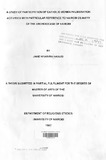| dc.description.abstract | The core of Liberation Theology is restoration of authenticity and, especially, the
liberation of the poor in whom we vividly find the dehumanised and depersonalised
humanity. This humanity has been undermined by poverty, starvation, subordination,
corruption, hunger, diseases and violation of human rights. The phenomena of street
children, HIV/AIDS patients and orphans, street mothers, street beggars, prostitutes,
school drop-outs, illiteracy, abandoned aged and incomplete families in Nairobi Deanery
call for emancipation, salvation and social praxis. These states suggest a depolarised
humanity of rich and poor, powerful and powerless, and proud and the humble. The
fact that all people are equal, created in the likeness of God, shows that both the
oppressors and the oppressed are dehumanised.
For a long time, women have been taken as passive objects of oppression and
liberation. But their position in the society has changed following much conscientisation
on liberation movements. The thesis, therefore, has four objectives namely a) To
examine the fundamental magisterial directives and social teachings of the Roman
Catholic Church on and about women in relation to liberation; b) To examine the impact
of the Church's social teachings and instructions on the liberational activities of the
Catholic women; c) To investigate and assess the liberational roles of Catholic women
in the socio-cultural, political, economic, religious, educational and other realms; and
d) To assess the role of the model of the Blessed Virgin Mary in inspiring Catholic -- _.women
in their Iiberational activities. To-help pursue these objectives three hypotheses
namely: a) The Catholic women in Nairobi ~nery are already involved in liberative
efforts and ministries to transform and humanise the society; b) The Church's
magisterium provides teachings, directives, support and challenges to Catholic women's
Iiberational participation; and c) The model of the Blessed Virgin Mary inspires the
Catholic women to help the oppressed find freedom from their oppressive states and to
live authentically; are tested thanks to the library and field work research.
The study comprises six chapters. Chapter One is the introduction. It elaborates
the research problem, the rationale for the study, the objectives, the scope of the study,
the literature review, research methodology, hypotheses and the theoretical framework
within which this study is carried out.ChapterTwo examines the Roman Catholic Church's
social teachings which ~_uide, support, direct, challenge and instruct the women's
liberational struggle. The social teachings include the Bible, the Documents of Vatican
Council II, Papal Encyclicals, Apostolic Exhortations and Papal Lettersl Addresses to
women. The reflections and teachings of the Kenya Episcopal Conference (KEC) and
Chapter Three forms the background in he African Synod are also provided.
Chapter Three forms the background information of the area of study, Nairobi
Deanery of the Archdiocese of Nairobi. It includes a historical overview, the geographical
spread, the population, the economy and the hierarchical structure of the Church. It
further presents the data collection, interpretation and analysis of the Catholic women's
insertion among the marginalised and their sources of pedagogy in effort to liberate the
dehumanised.
Chapter Four is an elaborate study of the Catholic women's existential approach
towards liberation. Different case studies which indicate that Catholic women in Nairobi
Deanery are already participating in liberation of the oppressed and the oppressors are
cited. The following dimensions of liberation have been discussed: the Church, the
Family, Education, Health, Social, Recreational, Communication Services, Public Life
and Economy within the framework of Catholic women's liberational roles.
Chapter Five is a critical appraisal of the role of Catholic women's liberational
efforts and ministries. Different approaches towards liberation have been discussed
namely: Educational, Self-Reliant, Community Based, Evangelisation and Aid/Relief
provision are discussed. The chapter also examines the role and impact of the model
of the Blessed Virgin Mary (B.V.M.) who is concretely acknowledged and appreciated
as an unparalleled model to Catholic,omen in their liberational roles as highlighted in
Her Magnificat. A brief dialogue betwe·en~.riological approach and Christological
perspective is also examined.
Finally, Chapter Six forms the recapitulations and conclusions of the study. Various
recommendations on Catholic women participation in humanising the society are
provided. Among the findings of the study is that Catholic women's liberational efforts
are entirely guided by the model of the B.V.M. as a Woman, thus, ignoring the exemplification of Jesus Christ into the periphery. | |

